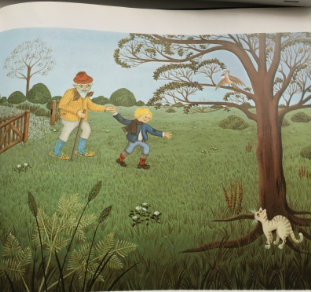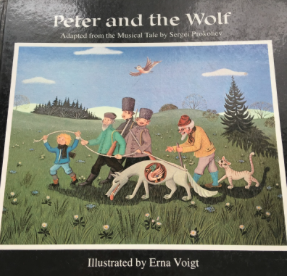Title: Peter and the Wolf
Author: adaptation from Sergei Prokofiev
Illustrator: Erna Voigt
Publisher: David R. Godine, 1979
Number of pages: 26
Tags: Adventure, Animals, Culture, Fiction, Fine Arts, Picture Book, Grace Sheley
Genre: Fiction
This retelling of Prokofiev’s symphonic fairy tale illustrates the popular story of Peter, a young boy, who helps various animals fight off the wolf. Before Peter could chase off the wolf, he gobbled up the duck whole. However, Peter fights the wolf off before he can eat the cat and the bird by tying a rope to his tail and connecting the rope to a tree. The story ends with Peter and some hunters taking the wolf to a zoo (with the duck still alive inside the wolf’s stomach).
The text is very simplistic, but it is enhanced by the musical instruments that are assigned to various characters – such as Peter’s violin and the wolf’s french horn. On a new page introducing a new character, the instrument’s line from Prokofiev’s symphony is included at the bottom of the text page. It is a great way for young students to be exposed to classical music, especially if the part is played for them on the instrument it is written for. The ideology behind the text is that a young boy who rebels against his grandfather’s words of caution about the meadow is suddenly a hero for his clever outsmarting of the vicious wolf. It is a story meant to inspire and empower young children, but perhaps the message is not the best due to Peter’s ignoring his elder’s advice. All end’s well, however, and Peter is the hero of the story.
The illustrations are vibrant and convey the folk-like atmosphere of the story and the music alike. The pages are divided by the left side being a text page with the musical excerpts and the right page being a framed illustration. The framed aspect conveys that a story is being told, that the reader is not a part of it, but observing it. There are no harsh lines, but the softness of the illustrations conveys a feeling of motion, of anticipation for the wolf’s inevitable arrival. On the page that the wolf arrives, the meadow’s previous bright and sunny colors suddenly turn darker. This mood shift assists the general feeling of suspicion and caution that arrives with the wolf’s prowling around the meadow. However, when Peter reenters to save the animals from the wolf, the lightness comes back, as though the sun has reappeared and all is saved. On the page describing when Peter has outsmarted the wolf and tied him to the tree, the wolf is at the bottom of the page (the lowest in power) and Peter is at the top of the page (the highest in power).


